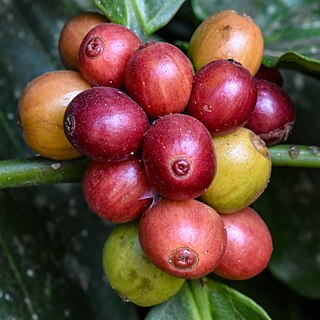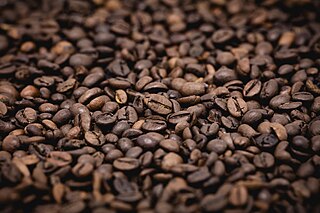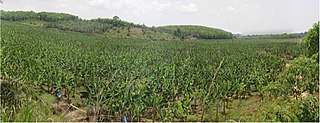Coffee production in Ivory Coast is important for the economy of the country as coffee is the second largest export commodity of the country. [1] It was the largest coffee producer in Africa in the 1970s and 1980s, [2] and one of the largest robusta producers in the world. [3] Today however, Ivorian coffee production has been far superseded by Vietnam and Brazil. It ranks 14th in the world ranking.
Coffee plants were introduced into the country in the 19th century by French colonizers. [4] Following World War II, coffee production increased from 36,000 tons in 1945 to 112,500 tons in 1958. [5] After Ivory Coast became independent (in 1960), coffee production peaked in the 1970s making it the third-largest coffee-producing country in the world, after Brazil and Colombia, before the civil war unsettled cultivation. [1] Coffee production and policy are derived from the era when Ivory Coast was a colony of French West Africa. This has attracted French companies to invest in the sector. [6]
Ivory Coast produces mostly robusta coffee. [7]
According to the FAOSTAT database of the United Nations Food and Agriculture Organization, production of "green" (i.e., unroasted) coffee beans in the Ivory Coast was the following (in tons): [8]
| Year | Coffee Produced (tons) |
|---|---|
| 1965 | 202,105 |
| 1970 | 279,610 |
| 1975 | 270,400 |
| 1980 | 249,608 |
| 1985 | 277,082 |
| 1990 | 285,164 |
| 1995 | 194,968 |
| 2000 | 380,000 |
| 2005 | 230,000 |
| 2010 | 94,372 |
| 2011 | 32,291 |
| 2012 | 121,426 |
| 2013 | 103,743 |
| 2014 | 114,387 |
| 2015 | 127,000 |
| 2016 | 106,000 |
| 2017 | 103,514 |
Production of green robusta coffee output in the nation peaked at 380,000 tons in 2000. [9] Production subsequently declined over more than a decade of upheaval in the country, particularly during the First Ivorian Civil War (2002–2007) and Second Ivorian Civil War (2010–2011). [9] In 2014, the Ivorian agriculture minister announced a new annual production target of 400,000 tons of coffee by 2020, about four times its present rate. [9]

Ivory Coast, also known as Côte d'Ivoire and officially the Republic of Côte d'Ivoire, is a country on the southern coast of West Africa. Its capital city of Yamoussoukro is located in the centre of the country, while its largest city and economic centre is the port city of Abidjan. It borders Guinea to the northwest, Liberia to the west, Mali to the northwest, Burkina Faso to the northeast, Ghana to the east, and the Atlantic Ocean's Gulf of Guinea to the south. With 30.9 million inhabitants in 2023, Ivory Coast is the third-most populous country in West Africa. Its official language is French, and indigenous languages are also widely used, including Bété, Baoulé, Dioula, Dan, Anyin, and Cebaara Senufo. In total, there are around 78 different languages spoken in Ivory Coast. The country has a religiously diverse population, including numerous followers of Islam, Christianity, and traditional faiths often entailing animism.

Coffea canephora is a species of coffee plant that has its origins in central and western sub-Saharan Africa. It is a species of flowering plant in the family Rubiaceae. Though widely known as Coffea robusta, the plant is scientifically identified as Coffea canephora, which has two main varieties, robusta and nganda.

Coffee is a popular beverage and an important commodity. Tens of millions of small producers in developing countries make their living growing coffee. Over 2.25 billion cups of coffee are consumed in the world daily. Over 90 percent of coffee production takes place in developing countries — mainly South America — while consumption happens primarily in industrialized economies. There are 25 million small producers who rely on coffee for a living worldwide. In Brazil, where almost a third of the world's coffee is produced, over five million people are employed in the cultivation and harvesting of over three billion coffee plants; it is a more labor-intensive culture than alternative cultures of the same regions, such as sugar cane or cattle, as its cultivation is not automated, requiring frequent human attention.

Agriculture in Indonesia is one of the key sectors within the Indonesian economy. In the last 50 years, the sector's share in national gross domestic product has decreased considerably, due to the rise of industrialisation and service sector. Nevertheless, for the majority of Indonesian households, farming and plantation remains as a vital income generator. In 2013, the agricultural sector contributed 14.43% to national GDP, a slight decline from 2003's contribution which was 15.19%. In 2012, the agricultural sector provides jobs to approximately 49 million Indonesians, representing 41% of the country's total labor force.

The mining sector of Ivory Coast contributes to 13% of the country's exports annually and accounts for 5% of the GDP. The industry has historically centered on the extraction of gold. Although the subsoil of Ivory Coast contains many other minerals, none had been discovered in commercially exploitable amounts.

Agriculture was the foundation of the economy in Ivory Coast and its main source of growth. In 1987 the agricultural sector contributed 35 percent of the country's GDP and 66 percent of its export revenues, provided employment for about two-thirds of the national work force, and generated substantial revenues despite the drop in coffee and cocoa prices. From 1965 to 1980, agricultural GDP grew by an average 4.6 percent per year. Growth of agricultural GDP from coffee, cocoa, and timber production, which totaled nearly 50 percent of Ivory Coast's export revenues, averaged 7 percent a year from 1965 to 1980.

Ivory Coast leads the world in production and export of the cocoa beans used in the manufacture of chocolate, as of 2024 producing 45% of the world’s cocoa.

The economy of Ivory Coast is stable and currently growing, in the aftermath of political instability in recent decades. The Ivory Coast's economy is largely market-based and depends heavily on the agricultural sector. Almost 70% of the Ivorian people are engaged in some form of agricultural activity. The economy grew 82% in the 1960s, reaching a peak growth of 360% in the 1970s, but this proved unsustainable and it shrank by 28% in the 1980s and a further 22% in the 1990s. This decline, coupled with high population growth, resulted in a steady fall in living standards. The gross national product per capita, now rising again, was about US$727 in 1996. It was substantially higher two decades before. Real GDP growth is expected to average 6.5% in 2024–25.

Coffee is an important agricultural product in the Philippines, and is one of the Philippines' most important export products aside from being in high demand in the country's local consumer market.

Agriculture in the Democratic Republic of the Congo is an industry in the country of the Democratic Republic of the Congo that has plenty of potential.

Laos produces two main types of coffee: Robusta and Arabica. Robusta is mainly used for regular coffee as well as a typical coffee drink in Laos where it is sweetened with condensed milk. The latter, Arabica, is of a higher quality due to its mild taste, and it is used for espresso. For the 20,000 tons of coffee that Laos produces a year, 5,000 tons are Arabica beans and 15,000 tons are Robusta.

Coffee has been grown in Cuba since the mid-18th century. Boosted by French farmers fleeing the revolution in Haiti, coffee farms expanded from the western plains to the nearby mountain ranges. Coffee production in eastern Cuba significantly increased during the 19th and early 20th centuries. At its peak production, Cuba exported more than 20,000 metric tons of coffee beans per year in the mid-1950s. After the Cuban Revolution and the nationalization of the coffee industry, coffee production slowly began to decline until it reached all time lows during the Great Recession. Once a major Cuban export, it now makes up an insignificant portion of Cuban trade. By the 21st century, 92 percent of the country's coffee was grown in area of the Sierra Maestra mountains. All Cuban coffee is exported by Cubaexport, which pays regulated prices to coffee growers and processors.

Coffee production in Democratic Republic of the Congo (DRC) is centered in the Lake Kivu provinces. There are about 11,000 coffee farmers in the country who produce two main species of coffee, Robusta and Arabica.
Coffee production in Panama was occurring in the Boquete Valley by the early 20th century, although coffee was growing wild all over the Pacific coast region of Panama by this time, when production did not match domestic consumption. The International Coffee Organization (ICO) has grouped mild arabica as the variety of coffee that is grown in Panama. The best quality of coffee in Panama is grown in Boquete. In the Coffee Review of 2008, two Panamanian coffees have received higher rating and fetched record prices than the coffee from Costa Rica. This is mainly due to the unprecedented success of the Geisha varietal. This varietal originated from and arrived via Tanzania and Costa Rica in the 1960s in Panama. But only in 2004, its outstanding taste profile was recognized. In 2019 one pound of Panama Geisha beans fetched $1,029 in an auction.

Coffee production in Sri Lanka peaked in 1870, with over 111,400 hectares being cultivated. The Dutch had experimented with coffee cultivation in the 18th century, but it was not successful until the British began large scale commercial production following the Colebrooke–Cameron Commission reforms of 1833. By 1860, the country was amongst the major coffee-producing nations in the world. Although coffee production remains a source of revenue, it is no longer a main economic sector. In 2014, the country ranked 43rd of largest coffee producers in the world.

Thailand is one of the top 25 coffee producers in the world as of 2014, but its status as a coffee origin has not been widely known. Thailand traditionally produced mainly Robusta for industrial use, but the country has quickly become an exciting emerging origin for specialty Arabica and fine Robusta coffees. The origin is unique in that it exports very little coffee and most of the consumption remains in the country. There is a booming specialty coffee ecosystem where farmers, roasters, cafes and consumers symbiotically co-exist. It is often seen as an example of a working coffee ecosystem for an origin where coffee produced is sustainable from both economic and environmental perspectives.

Agriculture is the main part of Tanzania's economy. As of 2016, Tanzania had over 44 million hectares of arable land with only 33 percent of this amount in cultivation. Almost 70 percent of the rich population live in rural areas, and almost all of them are involved in the farming sector. Land is a vital asset in ensuring food security, and among the nine main food crops in Tanzania are maize, sorghum, millet, rice, wheat, beans, cassava, potatoes, and bananas. The agricultural industry makes a large contribution to the country's foreign exchange earnings, with more than US$1 billion in earnings from cash crop exports.

With the world’s largest production of cacao and cashew nuts, Ivory Coast is one of the leading economic powers in West Africa. It joined the IMF in 1963. Since then, Ivory Coast participated in 14 arrangements and purchased more than 1016 millions in procurement and loans. It now possesses 650.4 million SDR of quotas.
Since becoming an independent country, Ivory Coast has transitioned from an economy dominated by agriculture—coffee and cocoa in particular—to a diversified economy with a large service sector. From 1960 to 1976, government policy focused on investing revenues from agricultural export into infrastructure. From 1976 to 1980, factors such as a boom-bust in coffee and cocoa prices, over-investment funded by foreign debt, and a devaluation of the US Dollar led Ivory Coast to the brink of financial crisis. Decreased revenues from coffee and cocoa exports continued into the 80's and early 90's, increasing the burden of foreign debt and eventually requiring lender negotiation. This resulted in the privatization of many state-owned enterprises with mixed levels of success. In 1994, the economy began a comeback due to devaluation of the CFA franc, increased export revenues, financial reforms, and debt rescheduling. Since then the economy has been impacted by and rebounded from political crises such as the 1999 coup d'état and the 2011 election crisis.